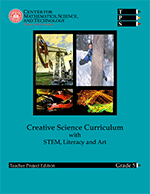Fifth Grade Science
Book Info

Pick Your Favorite
This lesson centers on the design and construction of a habitat containing a few very different environments. The greater the difference, the better. The habitat is made of several 2-liter bottles taped together to form a long tube. Students create the different environments by placing sand, water, plants, etc. inside the tube. They then put several different species of reptiles, animals, and insects inside the habitat and seal it up. Over the next few days and weeks, the species will move to their favorite location. Careful observation will reveal why they selected that area and what makes it most comfortable for them.
Laser Razzle Dazzle
This lesson centers on lasers. It will be very popular with your students. Lasers are fun. They can be used for some interesting applications. The lesson specifically addresses how the laser beam can be reflected and used to activate a switch. In the Application section, the students build a cajon drum that vibrates mirrors to produce a pattern on the wall. A cajon drum is simply a wooden box with a hole cut on one side. It is thought to have originated with African slaves being brought to the Spanish colonies in Peru. Being denied their usual instruments, they used common household items such as wooden drawers, crates, spoons, and even chairs to produce music. "Cajon" roughly translates to "box" in Spanish (www.cajon-drum.com). The percussionist sits on top and strikes the front with his/her hands. Striking the middle produces a low tone, striking the edge produces a higher tone. The drum built in this activity will not be strong enough to support the weight of the musician, but the design is the same.
The Big Picture
There are several aspects to this lesson. It primarily addresses how sedimentary rock is formed. Embedded (literally) in this process is the inclusion of fossils and fossil fuels. Erosion is addressed, which introduces the idea of prospecting and mining. Students will actually drill or mine for "organic" material. Finally, exhaustible, renewable, and inexhaustible forms of energy are identified and researched.
Just Add Heat
In this lesson students will be baking cupcakes. This will serve as an excellent way to measure quantities, identify mixtures, and experience chemical reactions. You will notice that quantities are listed in grams. This is unusual for baking, but common practice in scientific investigations.
Hot and Cold
Students will be exploring heat transfer through different materials. They will apply this knowledge as they design and build a steam-powered boat.
Its Coming
In this lesson, students will learn about weather conditions as they design, build, and utilize weather instruments. They will gather data over a period of time and look for patterns in the data. They will use the patterns to make predictions.
Organ Music
Students will be making working models of various systems of the human body in this lesson. One group will make a working heart from sandwich bags. Another will make a digestive system from plastic tubes. While still others will make lungs from balloons and a 2 liter bottle. There are also groups making a skeleton, muscles, and the circulatory system.